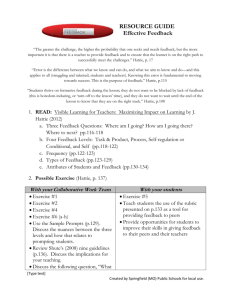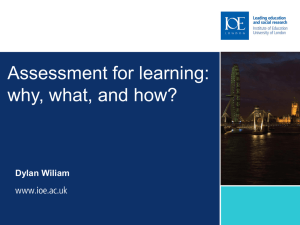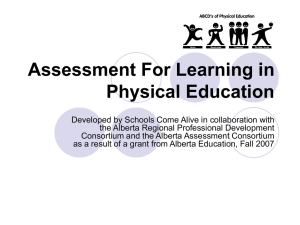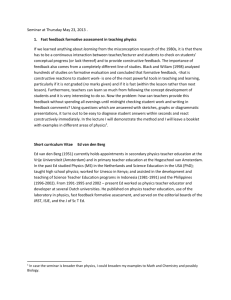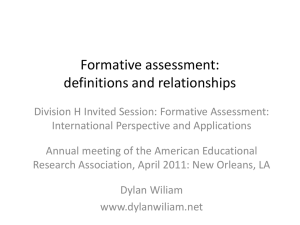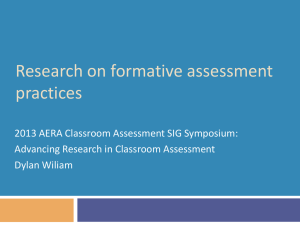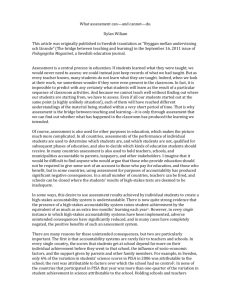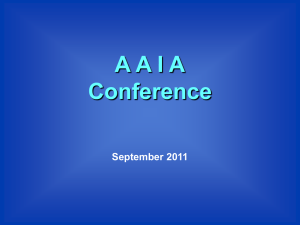The dataset includes a total of 16542 students in
advertisement
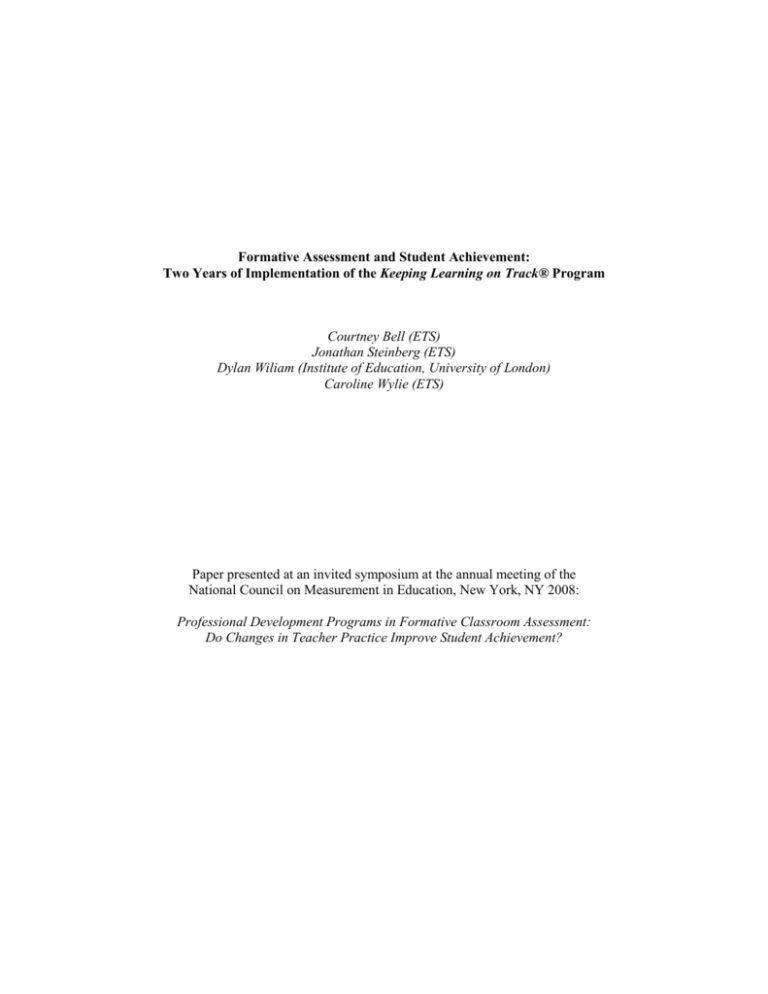
Formative Assessment and Student Achievement: Two Years of Implementation of the Keeping Learning on Track® Program Courtney Bell (ETS) Jonathan Steinberg (ETS) Dylan Wiliam (Institute of Education, University of London) Caroline Wylie (ETS) Paper presented at an invited symposium at the annual meeting of the National Council on Measurement in Education, New York, NY 2008: Professional Development Programs in Formative Classroom Assessment: Do Changes in Teacher Practice Improve Student Achievement? Formative Assessment and Student Achievement: Two Years of Implementation of the Keeping Learning on Track® Program Background Ten years ago, the appearance, and widespread dissemination, of a paper entitled “Inside the black box” simultaneously in the United Kingdom (Black & Wiliam, 1998a) and the United States (Black & Wiliam, 1998b) renewed interest in the idea that assessment should support instruction, rather than just measure its outcomes, although the idea itself dates back at least a further 30 years (see, for example, Bloom, Hastings & Madaus, 1971). A number of research reviews (Crooks, 1997; Natriello, 1998; Kluger & DeNisi; 1996; Black & Wiliam, 1998c; Nyquist, 2003; Brookhart, 2005) have both clarified some of the key concepts in the field, and produced a prima facie case that the impact on student achievement is likely to be sufficiently great to be worth exploring further. While Black & Wiliam (1998c) found that the available literature suggested that effect sizes of the order of 0.4 to 0.7 standard deviations were possible, these were often derived from studies conducted over relatively short periods of time, and using outcome measures that were highly sensitive to instruction. Evaluations of attempts to implement formative assessment in real classroom settings, over extended periods of time, using distal and remote measures of achievement typically find much smaller effects. For example, a study of mathematics and science teachers in secondary schools in two local education authorities in England (Black, Harrison, Lee, Marshall & Wiliam, 2003) found effect sizes around 0.3 standard deviations (Wiliam, Lee, Harrison & Black, 2004). The classic literature on effect sizes (e.g., Cohen, 1988) would suggest that these effect sizes are small. However, because standardized tests are relatively insensitive to instruction (Wiliam, 2007a), an effect size of 0.3 standard deviations represents an increase of well over 50% in the rate of learning. Moreover, the modest cost of these interventions mean that if they can be implemented at scale, they are likely to be as much as 20 times more cost-effective than class-size reduction programs (Wiliam, 2007b). For this reason, over the past five years, we and our colleagues at the Educational Testing Service (ETS) have been exploring how the benefits of formative assessments might be achieved at scale. The Keeping Learning on Track® Program The Keeping Learning on Track program is a school-based professional development program that supports teachers’ use of formative assessment in their everyday teaching, via sustained, school-based teacher learning communities. Through an introductory workshop followed by sustained engagement in school-based teacher learning communities, the Keeping Learning on Track program exposes teachers to a wide range of classroom techniques, all unified by a central idea: using evidence of student learning to adapt real-time instruction to meet students’ immediate learning needs. There are five research-based Keeping Learning on Track strategies (Leahy et al., 2005): o o o o o Engineering effective classroom discussions, questions, and learning tasks that elicit evidence of student learning; Clarifying and sharing learning intentions and criteria for success; Providing feedback that moves learners forward; Activating students as the owners of their own learning; Activating students as instructional resources for one another. Using the strategies as a framework, teachers are then introduced to practical, classroom techniques that they can use to implement the strategies. In addition to the introductory workshop, teachers continue to explore formative assessment ideas through structured, monthly teacher learning community meetings. Recent research into the mechanisms of effective teacher professional development provides support for Page 1 teacher learning communities (TLCs) as a central vehicle for sustained teacher learning, particularly where teachers are learning to change long-held, perhaps unconscious teaching practices (Grossman, Wineburg, & Woolworth 2001; Thompson, & Goe, 2006). Thus, teacher learning communities (TLCs) are an integral part of Keeping Learning on Track (Wiliam, 2007/2008). The Keeping Learning on Track (KLT) program has been implemented in California, Maryland, New Jersey, Ohio, Pennsylvania, Texas, and Vermont. In a symposium at the 2006 AERA conference, a team of ETS researchers who had been working on a research-based development effort around the Keeping Learning on Track program presented a series of papers focusing on the theoretical foundation of the intervention (Wiliam & Leahy, 2006), tools that had been developed for teachers’ use (Ciofalo & Leahy, 2006), evidence of how teachers used them (Wylie & Ciofalo, 2006), a theoretical outline of the model for teacher professional development that had been implemented in various locations (Thompson & Goe, 2006), and case study results from two separate implementations (Lyon, Wylie & Goe, 2006). At the 2007 annual meeting of AERA, a series of papers focused on impact of the intervention on teachers, teaching, and students (Ellsworth, Martinez, Lyon & Wylie, 2007; Wylie, Ellsworth & Martinez, 2007; Wylie, Thompson, Lyon & Snodgrass, 2007; Wylie, Thompson & Wiliam, 2007). This paper presents results from a quasi-experimental analysis that examines the impact of the Keeping Learning on Track program on student learning in one large urban school district, as measured by state-mandated standardized tests. KLT in Cleveland Metropolitan School District Beginning in October 2005, the KLT program was introduced to ten K-8 schools in the Cleveland Metropolian School District, chosen on the basis that their reading and mathematics scores on the Ohio Achievement Test (OAT) were amongst the lowest in the district. Because of our interest in effecting change at scale (Thompson & Wiliam, 2007), we deliberately designed the intervention to be one with as little contact between the originators of the program and the teachers who would participate in the Teacher Learning Communities. The intervention consisted of a one-day workshop for approximately 400 teachers (delivered on three separate days to groups of approximately 130 teachers), and monthly meetings for those charged with leading the TLCs in the schools, half of which were staffed solely by professionals from CMSD and half of which were augmented by researchers and developers from ETS. In the first year, the program focused on mathematics and the initial results were encouraging. Teachers participated with the program enthusiastically, and in the May 2006 administration of the OAT all ten of the KLT schools improved their math scores (compared with approximately half of the non-KLT schools in the district). Since the ten participating schools were some of the lowest performing schools, then a greater than average degree of improvement would be expected, but this “soft” index of success did create enough support for the program within the district to allow its continuation and expansion. At the end of the 2005-2006 school year, one of the ten original schools closed, but the other nine continued with the KLT program (as Cohort A), and an additional five schools (Cohort B) began the first year of the program in 2006-2007. Preliminary analyses of the 2004-05 and 2005-06 data (Wylie, Thompson & Wiliam, 2007) indicated that, apart from the 3rd grade mathematics assessment and 6th grade reading, the growth in mean scores for the KLT schools exceeded that of the non-KLT schools. However, as we commented at the time, considerable caution in interpreting these results is needed. There had been changes in the tests used during the 200405 and the 2005-06 school years, so that it was only possible to estimate relative changes in achievement, through the use of z-scores. Another limitation of the 2007 analysis was that it took no account of the clustering in the data—a limitation we are able to address in this analysis. Page 2 The dataset comprises those students enrolled in public schools in the Cleveland Metropolitan School District in Fall 2006 who were tested on the Ohio Achievement Test (OAT) in both 2005-06 and in 200607—16,550 students for reading and 16,542 students for math. Table 1 shows the numbers of students in each grade in each year for reading and math. As can be seen, 72 students were retained in grade 3 for both reading and math, and a similar number were retained in grade 8. In 2006-07, a total of 412 students were retained in the grade to which they had been allocated in 2005-06 (72, 56, 52, 58, 105, and 69 respectively in grades 3, 4, 5, 6, 7 and 8 for math, with similar figures for reading) while 89 were promoted by more than a single grade (including two, presumably erroneous, entries that appeared to be promoted by three grades). In other words, 97% of the cohort progressed by a single grade between 2005-06 and 2006-07 (16,041 students for math and 16,043 for reading), and these students are the focus of this analysis. Table 1: Students in grades 3-8 in math and reading classes, 2005-2006 to 2006-2007 Grade 3 4 5 6 7 8 Mathematics 2005-2006 2006-2007 3093 72 3073 3073 3162 3068 3442 3156 3703 3445 69 3728 Reading 2005-2006 2006-2007 3093 72 3074 3058 3158 3069 3450 3155 3717 3454 71 3670 As is common in urban districts, there is a substantial level of student mobility in Cleveland. Of the 16542 students in the math dataset, 4,400 changed school between 2005-06 and 2006-07, and the proportion was similar for the reading dataset (4,405 out of 16,550). Although we are aware that the students who changed school are not likely to be representative of those who did not, in this initial exploratory analysis, because we are interested in the effects of professional development programs on schools and teachers, we include only those students who were in the same school for both testing occasions. The achievement measures reported here are from the Ohio Achievement Test (OAT); a series of standardized tests administered to all students in grades 3 through 8 in Ohio Public Schools in May of each year. Details of the test administration, including technical matters related to equating can be found in Ohio Department of Education (2007). The scores on both the math and reading tests, for both 2005-2006 and 2006-07 were very close to being normally distributed, although the gain scores from one year to the next were slightly lepto-kurtic, possibly due to the effects of measurement error. Table 2 below provides the math OAT results in grades 3 to 7 in 2005-2006 and who progressed to grades 4 to 8 in 2006-2007, while Table 3 provides the reading results. Both tables have the same layout and provide the CMSD mean scores by grade level for both the 2005-06 and 2006-07 testing years, along with the 2006-07 statewide results. At every grade level, the statewide results exceeded the district level means. Page 3 Table 2: Characteristics of the mathematics component of the Ohio Achievement Test 2006-2007 2005-2006 CMSD Grade Mean SD 3 4 5 6 7 398.7 399.9 383.2 393.1 390.9 CMSD Grade Mean SD 26.5 28.8 26.1 29.3 22.2 4 5 6 7 8 398.2 383.2 391.4 396.0 396.0 Mean Statewide SD Reliability 420.1 409.2 423.1 414.0 412.8 30.4 29.0 30.8 21.1 20.7 32.9 32.5 38.3 27.1 25.6 0.88 0.90 0.89 0.85 0.85 Note: The number of students for CMSD analyses in 2005-06 and 2006-07 were 2273, 2299, 2239, 2409, and 2693 for grades 3-7, respectively. Table 3: Characteristics of the reading component of the Ohio Achievement Test 2005-2006 CMSD Grade Mean SD 3 4 5 6 7 400.6 403.5 396.3 408.4 403.7 27.6 30.8 32.0 26.6 27.2 2006-2007 Grade 4 5 6 7 8 CMSD Mean SD 405.4 401.5 399.6 400.2 403.8 29.9 28.8 24.5 25.4 24.1 Mean 424.6 421.5 419.0 418.9 420.7 Statewide SD Reliability 30.9 29.4 27.3 27.9 28.3 0.89 0.87 0.87 0.87 0.87 Note: The number of students for CMSD analyses in 2005-06 and 2006-07 were 2261, 2301, 2235, 2416, and 2703 for grades 3-7, respectively. Our prior analyses were based on single-level models (i.e., ignoring clustering effects), but we know that the assumptions necessary for such an analysis are not likely to be met in practice. The design of the KLT program, with its emphasis on school-based teacher learning communities, means that there is likely to be substantial within-school clustering, and we know from our observations of the meetings, and reports from TLC leaders, that there are sharp differences between the operation of the TLCs in different schools (Ellsworth, Martinez, Lyon & Wylie, 2007). Moreover, it is clear from observations in the classrooms that different teachers have had differing degrees of success in making the changes to their practices that are the focus of the KLT program, so there will be substantial within-class clustering too. This suggests that the existing experimental design is substantially under-powered. Even ignoring the clustering effects at classroom level (i.e., using a two-level design with students nested in schools) the power of this experimental design to detect an effect is quite low. Using the results of the 2005-2006 test as a covariate, and a 95% confidence level, the chance to detect an effect size of 0.25 standard deviations is approximately 50%. It is therefore not surprising that a hierarchical linear model of 2006-2007 math and reading scores—with students nested in schools nested in treatments and with 2005-2006 scores as a covariate—found no significant differences between schools following the KLT program and the other schools in the district. In fact, the differences between KLT schools and non-KLT schools were so far from statistically significant (many of the p values were above 0.5) that the lack of statistically significant findings may not be attributable to the low power of the experiment, but rather that the effects produced by the KLT Page 4 intervention were too small to be detected, and smaller than had been found in other implementations of formative assessment. In order to investigate this further, we conducted a series of exploratory analyses. As well as comparing the schools doing KLT for 1 and 2 years with the non-KLT schools, we also identified a group of non-KLT schools with demographic characteristics as similar as possible to the 1-year and 2-year KLT schools. We created a data set of all the schools in Cleveland with their demographic variables of interest. We identified the cohort A and cohort B schools. The remaining schools we sorted by enrollment numbers and proportion of students with limited English proficiency (LEP). We wanted to select matched schools that were of similar size and proportion of LEP students (this was because several schools in each cohort had a large proportion of second language students). Other variables then used to sort schools were: % of longevity (measure of teacher turnover) % of African American students Accountability designation in 06-07 (defined by state accountability system) Year of improvement status (defined by state accountability system) % of core courses not taught by a highly qualified teacher If a tie-breaker was needed, the final category was % of special education students For each of the 14 KLT schools we used the variables to select a matched school, as shown in Table 4. Table 4: Characteristics of KLT schools and their matched schools Enrollment %LEP % longevity % African American students % White students Accountability designation Year of improvement status Courses w/out HQ teacher Special Education Cohort A (9 schools) Matched to A (9 schools) Cohort B (5 schools) Matched to B (5 schools) 568 0 to 54% 18.6% 69.3% 9.6% 4 on academic emergency; 3 on academic watch, 2 on continuous improvement 1 in year 3 3 in year 4 2 in year 5 3 in year 6 33.6% 16.6% 473 0 to 67% 16.7% 66.5% 9.0% 6 on academic emergency; 3 on academic watch 456 0 to 36% 16.8% 63.9% 15.3% 3 on academic emergency; 1 on academic watch, 1 on continuous improvement 3 in year 3 2 in year 4 402 0 to 28% 17.4% 67.4% 15.1% 2 on academic emergency; 2 on academic watch 35.4% 15.7% 33.1% 14.9% 3 in year 1 5 in year 2 1 in year 3 34.0% 14.2% 4 in year 1 1 in year 2 Using these matched schools, we compared the KLT schools with the matched schools, and with the other schools in CMSD. We created a hierarchical linear model investigating the achievement of students of the students in the 2006-2007 tests in the different categories of schools (1-year KLT, 2-year KLT, 1-year matched schools, 2-year matched schools, other schools) with students nested in schools nested in treatment, and with 2005-2006 scores as a covariate. Page 5 Tables 5 and 6 show the coefficients in the resulting model for math (Table 5) and reading (Table 6) with separate analyses conducted for each grade. For example, in 2006 -2007 on the math component of the fourth grade OAT, students in the schools that had been doing KLT for one year scored 44 points below what would be expected, given their scores on the third grade test in 2005-2006. Students in schools in their second year of KLT scored 8 points better than expected, those in non-KLT schools scored one point below expectation, and those in the non-KLT schools matched to the 1-year and 2-year KLT schools outperformed expectations by 18 and 19 points respectively. As can be seen from the p-values, none of these effects was significant. The only suggestion of an effect of the KLT program is for reading, in fourth and fifth grades, and only for schools in their second year of implementing the KLT program. Table 5: Coefficients of 2006-2007 mathematics scores on school type KLT schools Grade 4 5 6 7 8 1 Year (cohort B, N=5) -44 -38 -7 -11 -18 2 Years (cohort A, N=9) 8 42 5 -3 -5 Non KLT schools Matched Schools All non-KLT 1 Year 2 Years schools (N=73) (N=5) (N=9) -1 18 19 -2 -4 2 -26 26 2 -4 -2 19 -13 36 0 p value 0.89 0.60 0.84 0.89 0.84 Table 6: Coefficients of 2006-2007 reading scores on school type KLT schools Grade 4 5 6 7 8 1 Year (cohort B, N=5) -23 -32 9 15 19 2 Years (cohort A, N=9) 24 43 17 -16 -7 Non KLT schools Matched Schools All non-KLT 1 Year 2 Years schools (cohort B, (cohort (N=73) N=5) A, N=9) 16 -44 26 25 -19 -17 -5 -13 -9 1 15 -15 31 -36 -7 p value 0.52 0.10 0.82 0.75 0.08 Discussion The “theory of action” for the KLT program is complex, and multi-faceted (see Thompson & Wiliam, 2007 for an extended description). By intervening with teachers, the program aims to change their classroom behaviors in order to improve student outcomes by (a) increasing students’ engagement in classroom learning processes and (b) by providing teachers with information that makes their instruction more responsive to, and therefore better suited to, student learning needs. Ideally, therefore, we would have investigated the impact of the intervention on teachers’ classroom behaviors, then investigated the impact of these changes on student engagement and instructional quality, and only then look at the impact of these changes on students’ learning outcomes. Page 6 Because we did not have access to any mediating variables, such as changes in teacher knowledge, teacher practice, student engagement or student attitudes during the 2006-07 school year, we were forced to rely on an over-simplified theory of action. When forced to ask the simplistic question “Did the KLT program improve student outcomes” our answer has to be “No.” Of course, no evidence of impact, is not the same as evidence of no impact, and it seems that we need better designed studies if we are properly to evaluate the KLT program. Perhaps the major limitation of the current study is that we have no evidence about the extent or the fidelity of the implementation of the program, and this evidence would need to be at two levels. The first is whether the schools did, in fact implement the introductory workshops together with the support for the teacher learning communities as required by the program, and if so, with whom. The second is whether teachers who were involved in the program did make changes in their classroom practice as a result of the program. From the limited evidence that we do have, it seems likely that the both the extent and the fidelity of the implementation of the program are likely to be limited. A stronger design would also make use of individual student data so as to control more carefully for previous achievement. Wylie, Lyon, Ellsworth, Martinez (2007) documented the first year of history of the KLT program’s implementation in Cleveland. While considerable progress was made in the participating schools, institutional barriers appeared to reduce the potential success of the program in terms of the competing initiatives that participating schools and teachers were required to juggle. It is also worth reporting that the district itself experienced many changes over the period during which KLT has been implemented in CMSD. The lead district coordinator for the project left the district during the 2006-07 school year, as did one of the two team members who shared the responsibility with her. Although five new schools came on board at the start of the second year the collaboration between ETS and the district dropped off significantly. The KLT consultant assigned to the district conducted the training at the start of the year but in spite of repeated attempts to make himself available for consultation his offers were never taken up. We have some limited evidence that the schools were dealing with multiple (and competing) initiatives that also impacted the implementation fidelity. Despite our repeated attempts to discover the number of teachers participating in each school, we were unable to do so, although anecdotal information suggests the participation rate was nowhere near 100%. We know that KLT can be a significant component of successful school improvement efforts (Maher & Wiliam, 2007), but it is clear that implementation of this program presents significant challenges, especially in districts where it is one amongst many competing priorities. If we are to understand the problems of implementation, we need much more fine-grained detail about what happens on the ground. As noted above, it seems that the failure to find evidence of impact on student outcomes was, in this study, a matter of small effects, rather than lack of statistical power. However, it is worth noting that even if the effects had been as large as we hoped, it would require very large number of schools to participate in the study in order to generate statistically significant results. There is increasing agreement in the school improvement literature that although improving student outcomes is mostly a matter of improving the quality of individual teachers (Nye, Konstantopoulos & Hedges, 2004), this improvement must be a whole-school effort (Leithwood, Harris & Hopkins, 2008). What this means is that the unit of analysis for any evaluation of such reforms must be the school, due to the likely clustering effects, thus considerably reducing the power of any design. Konstantopoulos (2006) shows that, if we accept the necessity of a three-level design due to the nesting of students within classes, and classes within schools, the power to detect an effect size of 0.2 standard deviations in a study involving 100 schools is only 0.75, even with reasonable covariates (without covariates, the power would be around 0.4). Although such an effect size would be regarded as small by some authors (e.g., Cohen, Page 7 1988), due to the fact that standardized achievement tests are relatively insensitive to instruction (Wiliam, 2007), an effect size of 0.2 would represent an increase in the rate of student learning of at least 50%. Achieved across a system, this would result in students achieving by the end of eighth-grade what is currently achieved by the end of twelfth grade. In studying the effects of teacher professional development on student outcomes, statistically significant findings will be very hard to generate. In the longer term, it may, in fact be possible to develop large scale trials, involving 100 or more schools. However, in the shorter term, we believe that a much more appropriate course of action is to investigate ways of measuring fidelity of implementation and what it takes to implement KLT. Such lessons have begun to be learned in the context of work by states such as Vermont who began with a pilot but then moved towards scale (Tocci & Taylor, 2007; Bruccoli, Taylor, Wylde, 2008). We are learning about the importance of political buy-in at every level of the system and the need to attend to local contexts and specifically to existing local initiatives. We are beginning to understand ways in which initial piloting at a particular location may look different from later implementations as the work is absorbed into the standard work of the district. Future work can build on these lessons and from there, move to collecting student achievement data in locations were we are more secure about the quality of implementation. Conclusion This paper used student achievement data from the 2005-06 and 2006-07 school years to examine the impact of the Keeping Learning on Track (KLT) program. There were two cohorts of participating schools. By the end of the 2006-07 school year, participating teachers in Cohort A schools had completed two years of the KLT program, and Cohort B teachers had completed a single year. The program included an introductory workshop for all participants that introduced them to the research-basis for a framework of formative assessment strategies used in the program along with practical techniques that they could use to implement these strategies. Teachers met in school-based TLCs which met monthly for two hours, or more frequently for shorter periods of time. Materials were provided to structure and support each meeting. In addition, TLC leaders were provided with an initial workshop to orient them to their role as leaders along with monthly TLC leader meetings. While we had been able to collect implementation data during the first year of the program there were problems with the student achievement data because there had been changes in the tests used during the 2004-05 and the 2005-06 school years, so that it was only possible to estimate relative changes in achievement, through the use of z-scores. After the second year of the program we had access to two years of student data, on a consistent set of tests, but no implementation data. However, we did have some indication that the district was struggling to support the program, and there was a significant turn-over in staff which further hindered the work. A hierarchical linear model of 2006-2007 math and reading scores—with students nested in schools nested in treatments and with 2005-2006 scores as a covariate— found no significant differences between schools following the KLT program and the other schools in the district. After identifying matched schools, a second hierarchical linear model was used to investigate the achievement of students of the students in the 2006-2007 tests in the different categories of schools (1year KLT, 2-year KLT, 1-year matched schools, 2-year matched schools, other schools) with students nested in schools nested in treatment, with 2005-2006 scores as a covariate. Again results indicated that we have no evidence of impact of the KLT program. Although we know that no evidence of impact, is not the same as evidence of no impact, it will be important moving forward that we have better designed studies if we are to evaluate the KLT program. Student achievement data without fidelity information makes it difficult to sort out competing hypotheses. Lessons from other sites currently implementing KLT will inform future efforts to measure and account for implementation variation (Tocci & Taylor, 2007; Bruccoli, Taylor, Wylde, 2008). Page 8 References Black, P. J., & Wiliam, D. (1998a). Inside the black box: raising standards through classroom assessment. London, UK: King’s College London School of Education. Black, P. J., & Wiliam, D. (1998b). Inside the black box: raising standards through classroom assessment. Phi Delta Kappan, 80(2), 139-148. Black, P. J., & Wiliam, D. (1998c). Assessment and classroom learning. Assessment in Education: Principles Policy and Practice, 5(1), 7-73. Bloom, B. S., Hastings, J. T., & Madaus, G. F. (Eds.). (1971). Handbook on the formative and summative evaluation of student learning. New York, NY: McGraw-Hill. Brookhart, S. M. (2005). Research on formative classroom assessment. Paper Presented at the Annual Meeting of the American Educational Research Association: Montreal, Canada. Bruccoli, A., Taylor, G., Wylde, G. (2008). Growing Beyond a Pilot: Product Integrity in Environments of Dynamic Cultural Change. Paper presented at the Symposium entitled "The role of the State in formative assessment" at the annual conference of the American Educational Research Association held at New York, NY. Cohen, J. (1988). Statistical power analysis for the behavioural sciences. Hillsdale, NJ: Lawrence Erlbaum Associates. Ellsworth, J., Martinez, C., Lyon, C., & Wylie, E. C. (2007). Leading while learning: supporting the leaders of Keeping Learning on Track teacher learning communities Paper presented at the Annual conference of the American Educational Research Association held at Chicago, IL.Princeton, NJ: Educational Testing Service Grossman, P., Wineburg, S. & Woolworth, S. (2001). Toward a theory of teacher community. Teachers College Record, 103(6), 942-1012. Konstantopoulos, S. (2006). The power of the test in three-level designs (Discussion Paper 2412). Bonn, Germany: Forschungsinstitut zur Zukunft der Arbeit (Institute for the Study of Labour). Leahy, S., Lyon, C., Thompson, M., & Wiliam, D. (2005). Classroom assessment that keeps learning on track minute-by-minute, day-by-day. Educational Leadership, 63(3), 18-24. Leithwood, K., Harris, A., & Hopkins, D. (2008). Seven strong claims about successful school leadership. School Leadership and Management, 28(1), 27 - 42. Maher, J., & Wiliam, D. (2007). Keeping learning on track in new teacher induction Paper presented at the Symposium entitled "Tight but loose: scaling up teacher professional development in diverse contexts" at the annual conference of the American Educational Research Association held at Chicago, IL. Nye, B. A., Konstantopoulos, S., & Hedges, L. V. (2004). How large are teacher effects? Educational Evaluation and Policy Analysis, 26(3), 237-257. Ohio Department of Education (2007). May 2007 Ohio Achievement Tests Administration: Statistical Summary. Retrieved on February 20th, 2008 from http://www.ode.state.oh.us/GD/DocumentManagement/DocumentDownload.aspx?DocumentID=3297 3. Thompson, M., and Goe, L. (2006). Models for Effective and Scalable Teacher Professional Development. Presented at the annual meeting of the American Educational Research Association (AERA) and the National Council on Measurement in Education (NCME) held between April 6 to 12, 2006, in San Francisco, CA. Thompson, M., & Wiliam, D. (2007). Tight but loose: a conceptual framework for scaling up school reforms. Paper presented at the Symposium entitled "Tight but loose: scaling up teacher professional development in diverse contexts" at the annual conference of the American Educational Research Association held at Chicago, IL. Tocci, C., & Taylor, G. (2007). A State-Sponsored Pilot Project in Selected Schools in Vermont. Paper presented at the Symposium entitled "Tight but loose: scaling up teacher professional development in Page 9 diverse contexts" at the annual conference of the American Educational Research Association held at Chicago, IL. Wiliam, D. (2007). An index of sensitivity to instruction Paper presented at the Symposium entitled "Three practical policy-focused procedures for determining an accountability test's instructional sensitivity" at the annual conference of the American Educational Research Association held at Chicago, IL. Wiliam, D. (2007/2008, December/January). Changing classroom practice. Educational Leadership, 65(4), 36-42. Wylie, E. C., ., Lyon, C., Ellsworth, J., & Martinez, C. (2007). How formative assessment ideas translate from talk to practice Paper presented at the annual meeting of the American Educational Research Association (AERA), Chicago, IL. Wylie, E. C., Thompson, M., Lyon, C., & Snodgrass, D. (2007). Keeping Learning on Track in an urban district's low performing schools Paper presented at the annual meeting of the American Educational Research Association (AERA), Chicago, IL. Wylie, E. C., Thompson, M., Wiliam D. (2007). Keeping Learning on Track: Impact on Student Learning. Presented at the annual meeting of the American Educational Research Association (AERA), Chicago, IL. Page 10
